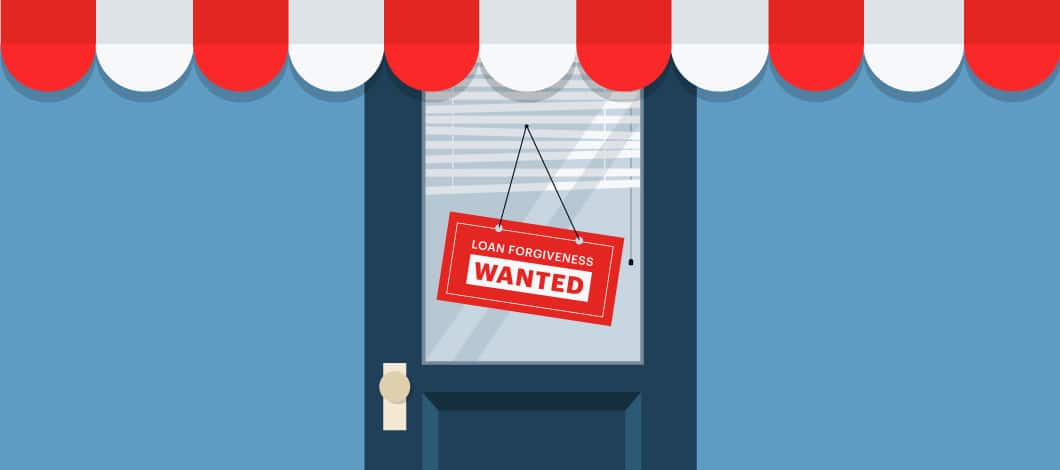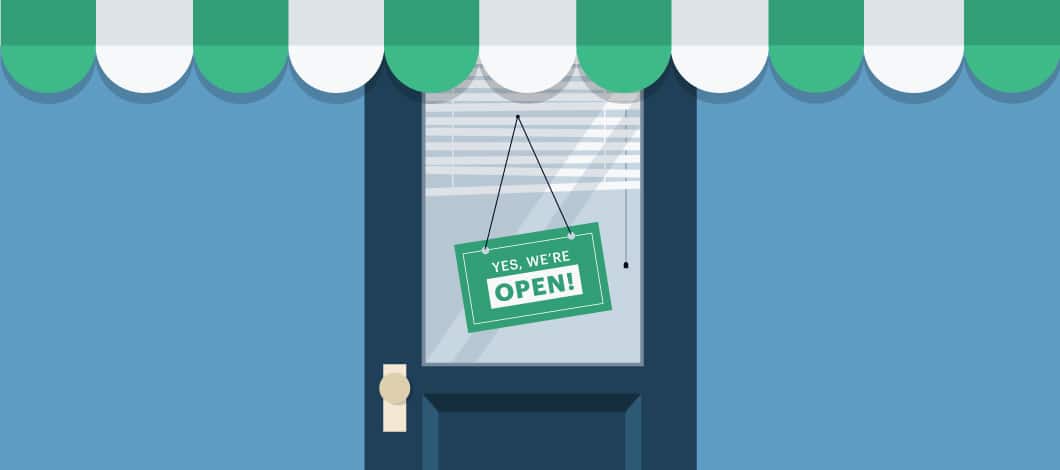Paycheck Protection Program (PPP) loan forgiveness can allow you to cover your company’s payroll costs without repayment obligations.
We’ll walk you through a 5-step procedure for filling out your PPP loan forgiveness application:
- Obtain your correct PPP Forgiveness Application Form
- Enter your basic information on your Loan Forgiveness Calculation form
- Use your Schedule A worksheet to verify your headcount and pay requirements
- Use Schedule A to calculate your payroll and compensation costs
- Complete your Loan Forgiveness Calculation form to determine eligible costs and forgiveness amount
We’ll also cover the basics of what Paycheck Protection Program forgiveness is and how to determine if you qualify.
What Is PPP Loan Forgiveness?
The PPP was created by the Coronavirus Aid, Relief and Economic Security (CARES) Act enacted on March 27, 2020. It extended loans to small businesses for the purpose of covering payroll and overhead expenses to keep employees working. After a number of extensions and amendments, the program was reopened in January to allow for new PPP funding applications as well as second draw opportunities for certain participants in the original program.
Under the PPP’s original terms, small businesses with up to 500 employees could apply for loans, with alternate maximum numbers of employees used for certain industries. Loans could be borrowed in sums up to $10 million for 2-year terms at 1% interest, with the initial payment deferred for 6 months. Borrowers could receive loan forgiveness if funds were used for payroll costs and other authorized operating expenses in the 8 weeks after loan origination.
The latest round of PPP funding comes with several updates. Notably, in addition to providing for new “First Draw PPP Loans” with a $10 million cap like original PPP loans, the latest PPP update allows certain qualified recipients of previous PPP loans to apply for a “Second Draw PPP Loan” of up to $2 million. Under the latest round of funding, both First Draw PPP Loans and Second Draw PPP Loans include opportunities for loan forgiveness.
Who Qualifies for PPP Loan Forgiveness?
The latest PPP loan forgiveness requirements are similar for First Draw PPP Loans and Second Draw PPP loans. To qualify for forgiveness, borrowers must meet certain conditions throughout a “covered period” of loan deferral following loan disbursement, which can be set at 8 or 24 weeks as requested by the borrower.
These conditions are as follows:
- Employee levels and compensation levels must be maintained where they were at the time funds were borrowed
- Loan proceeds must be spent on payroll costs and other authorized expenses
- At least 60% of loan funds must be spent on payroll costs
Borrowers who meet these PPP loan forgiveness rules may apply to have their repayment obligations lifted.

How Do I Apply for PPP Loan Forgiveness?
Preparing your SBA PPP loan forgiveness application requires you to select the correct form, enter some basic information, use a worksheet to verify eligibility and then use a schedule to calculate your costs and complete the form.
Here’s how to complete each of these steps:
1. Obtain Your Correct PPP Forgiveness Application Form
When preparing your SBA loan forgiveness application, you can use one of several different forms in the SBA Form 3508 series. Which form you should use depends on your situation:
- The standard form applicable in most situations is the SBA’s Form 3508
- If you received a loan of $150,000 or less, you can use a simplified version of a Form 3508 called a Form 3508S
- If you’re self-employed and received a loan of more than $150,000, you may be able to use a different simplified form called a Form 3508EZ provided that you meet a few additional conditions
The additional conditions to qualify for filing a 3508EZ are:
- You have no employees
- If you have employees, during the covered period, you didn’t reduce the annual salary or wages of employees earning $100,000 or less by more than 25%, plus either 1.) you didn’t reduce your average number of employers or employee hours of employees between Jan.y 1, 2020, and the end of your covered period, or 2.) you were unable to operate in the same capacity as you did on Feb. 15, 2020, because of official health regulations
In some cases, your lender may provide you with the equivalent of one of these forms.
The biggest difference between these forms is that the standard Form 3508 requires you to incorporate data from a supplementary form called a Schedule A, while the other versions let you skip this step. Because of this, the standard 3508 is the longest version of the form.
The 3508S further omits sections included on the 3508EZ form, reducing the financial data you need to enter to just a few fields. This makes the 3508S the simplest version of the 3508 series.
Depending on which version of the Form 3508 you use, the remaining steps in your PPP loan forgiveness application will vary in detail, while remaining generally similar. Each form includes instructions with detailed PPP loan forgiveness guidelines.
2. Enter Your Identifying Information
All 3 versions of the Form 3508 start by requesting similar basic information, which may include (depending on the form and your situation):
- Business legal name
- Doing business as (DBA) or tradename, if applicable
- Business taxpayer identification number (TIN), which can be an employer identification number (EIN) or Social Security number (SSN)
- Business address
- Business phone
- Primary contact
- Business email
- The North American Industry Classification System (NAICS) code used to classify the type of business you do
- The SBA PPP number assigned to you at the time of your loan
- Your lender’s PPP loan number
- Your PPP loan amount
- Number of employees you had at the time of your loan application
- Number of employees you have at the time of your forgiveness application
- The PPP loan disbursement date when you received your funds
- Any amount you received for an Economic Injury Disaster Loan (EIDL)
- An EIDL application number, if applicable
- Your loan forgiveness amount
After this section, instructions will vary based on your situation and the type of form you’re using. If you’re using the 3508S or 3508EZ, you will be able to skip some of these steps.
3. Verify Headcount and Pay Requirements
From here, we’ll focus on instructions for the standard Form 3508, which is the longest version of the form and contains everything from the other forms along with some additional sections. After the section with basic information, the rest of the Form 3508 consists of sections for:
- Forgiveness amount calculation
- Signature authorization
- PPP Schedule A, a form where you gather information about payroll and compensation costs to be used for filling out your forgiveness amount calculation
- PPP Schedule A worksheet, used to gather information for filling out your Schedule A
- An optional PPP borrower demographic information form asking questions about veteran status, gender, race and ethnicity
Since you need information from your Schedule A worksheet to complete your Schedule A, and you need your Schedule A to complete your forgiveness amount calculation, we’ll proceed in reverse order by starting from your worksheet and working back toward your Schedule A and finally the main form where you started filling out basic information.
The Schedule A worksheet includes a few main sections:
- A table for listing identifying information, cash compensation, scheduled hours divided by hours for a full-time workweek (called average full-time equivalent or FTE) and salary/hourly wage reductions for all employees earning $100,000 or less
- A similar table for all employees earning more than $100,000
- Step-by-step instructions for determining if you’ve met “safe harbor” forgiveness requirements for maintaining payroll based on your FTE calculations
Once you complete this information, you can use it to complete your Schedule A.
4. Calculate Your Payroll and Compensation Costs
On your Schedule A, you enter:
- Worksheet information on cash compensation, average FTE and salary/hourly wage reduction for employees earning $100,000 or less
- Worksheet information on cash compensation and average FTE for employees earning more than $100,000
- Information on noncash compensation payroll costs for insurance, retirement plans and state and local taxes
- Information on compensation to owners
- Total payroll costs, tallied from the above
After entering this, you complete a section determining whether you satisfy any of 3 criteria for “safe harbor” forgiveness requirements:
- You didn’t reduce employees or average paid hours for the covered period
- You were unable to operate at the same level as prior to Feb. 15, 2020, between that date and the end of your covered period due to official health and safety regulations issued between March 1, 2020, and Dec. 31, 2020
- You meet safe harbor requirements based on your Schedule A worksheet FTE calculations
If you meet any of these criteria, you enter a 1.0 on a line for what is called your FTE Reduction Quotient.
5. Complete Your Loan Forgiveness Calculation Form to Determine Eligible Costs and Forgiveness Amount
After completing the above items, you can resume completing the main part of your application. Following the section where you entered the basic information covered earlier, there is a column where you enter information and perform calculations for:
- Payroll and nonpayroll costs, including payroll cost data from your Schedule A
- Adjustments for FTE and salary or hourly-wage reductions, including wage reduction data and FTE Reduction Quotient data from your Schedule A
- Potential forgiveness amounts, based on applying a formula to the above data and your loan amount
- Your forgiveness amount, based on comparing the results of the above calculations with 60% of your payroll costs and taking the lesser of these 2 amounts
To simplify these calculations, some sites provide an online PPP loan forgiveness calculator you can use to get a quick estimate on how much of your loan may be forgiven. However, these types of calculator tools are designed for rough approximations and may not incorporate all the information from your Schedule A.
For accuracy, you should be careful to work through each line of your actual form rather than relying on a calculator tool. If you need assistance, your loan officer or a professional accountant can help you fill out your form.
Apply for PPP Loan Forgiveness to Avoid Extra Expenses
The PPP program provides an opportunity to cover your payroll costs without incurring any expenses. Avoid unnecessary expenses by following the proper procedures to submit your application.
If you haven’t yet applied for a PPP loan, or if you have used up your funds from a previous application, you may be eligible for additional financing through the latest round of PPP loans which opened in January 2021 and will remain open until March 31, 2021. Check out our blog for more details on the new round of PPP loans and other business financing opportunities you may be eligible for.











